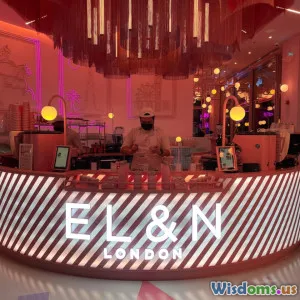
HandDrawn vs Digital Art Which Wins for Commercial Branding
7 min read Hand-drawn or digital art: discover which excels in commercial branding and why it matters. (0 Reviews)
Hand-Drawn vs Digital Art: Which Wins for Commercial Branding?
In today's visually driven marketplace, the question of how best to capture a brand's identity has never been more critical. As companies keenly balance authenticity with modernity, designers and marketers often grapple with one compelling dilemma: Hand-drawn or digital art for commercial branding? Both offer unique advantages and distinct appeals, sparking a creative debate that shapes consumer perception and brand success.
The Power of First Impressions: Why Art Medium Matters
Your brand's visuals are often the first touchpoint with your audience. According to data from the Nielsen Norman Group, users tend to form opinions about websites within 50 milliseconds, a judgment largely influenced by visual design. Translating this to broader branding, the artistic medium can subconsciously impact brand trust, recognition, and memorability.
But which medium creates the best visual experience for commercial branding? Let’s explore the key features, use cases, and real-world success stories of hand-drawn and digital art.
Understanding Hand-Drawn Art in Branding
Defining Characteristics
Hand-drawn art encompasses creative work made manually using pencils, pens, brushes, or other traditional media. Its hallmark is uniqueness, nuanced imperfections, and a tactile presence that often evokes warmth and personality.
Authenticity and Emotional Connection
Brands leveraging hand-drawn visuals frequently gain an aura of authenticity. This human touch can foster emotional connections, making brands appear more approachable and trustworthy. For example, Mailchimp's original branding featured playful hand-drawn illustrations, reinforcing the brand's friendly and creative identity.
A 2017 study published in the Journal of Consumer Research found that consumers viewed products with hand-drawn labels as more artisan and authentic compared to digitally designed counterparts.
Creative Flexibility and Limitations
Hand-drawn art allows unprecedented creative freedom, especially in styles that incorporate whimsy, sketchiness, or a retro feel. However, scaling and consistency across various media can be challenging. There’s also the consideration of time intensity—producing and revising hand-drawn work is often slower than working digitally.
Real-World Examples
- Innocent Drinks: Their branding uses hand-drawn elements extensively, building a quirky, friendly personality that distinguishes them in a crowded market.
- Ben & Jerry’s: This iconic ice cream brand uses a mix of hand-drawn typography and illustrations in advertising to express a homely and vibrant brand ethos.
The Rise of Digital Art in Branding
Characteristics and Advancements
Digital art employs software such as Adobe Illustrator, Photoshop, or Procreate to create clean, flexible, and scalable designs. It allows rapid iterations and easy modifications, ideal for the dynamic demands of modern branding.
Consistency and Scalability
When it comes to maintaining brand guidelines across multiple platforms—from social media to billboards—digital art reigns supreme. Vector-based illustrations guarantee sharpness in any size or resolution, providing brands with agility and consistency.
Technological Integration and Innovation
Digital art easily incorporates animation, interactivity, and 3D effects, breaking the static boundaries of traditional visuals. Brands like Slack and Airbnb utilize polished digital designs that communicate professionalism and innovation.
Real-World Examples
- Spotify: Employing vibrant digital vectors and sleek interfaces, Spotify's brand identity communicates dynamism and modernity.
- Apple: Known for minimalist and precise digital art in branding, Apple’s style reflects cutting-edge sophistication.
Comparative Analysis: Which Medium Suits Which Brand?
Industry and Audience Considerations
- Creative and Artisan Brands: Hand-drawn styles often excel in artisanal food, handmade crafts, or boutique sectors where genuineness is paramount.
- Tech and Corporate Sectors: Digital artwork aligns well with technology firms, startups, and enterprises emphasizing innovation and clarity.
Cost and Production Time
Digital design software has drastically improved efficiency and reduced costs. On the other hand, hand-drawn artwork may lead to higher upfront creative investment but can justify itself through unique brand personality.
Emotional Resonance vs Precision
While hand-drawn art fosters warmth and human connection, digital art emphasizes precision, perfection, and adaptability.
Bridging the Gap: Hybrid Approaches
Many brands today successfully blend hand-drawn and digital elements. For instance, Oreo’s campaign in 2022 married hand-drawn sketches with sleek digital animation for engaging storytelling. This fusion approach leverages the emotional pull of traditional art with the flexibility of digital production.
Conclusion: Making the Choice for Your Brand
Ultimately, deciding between hand-drawn and digital art boils down to your brand’s identity, target audience, and marketing goals. Hand-drawn art shines when authenticity, personality, and relatability are vital, imparting a unique touch that resonates on a personal level. Digital art excels in delivering consistency, scalability, and modern appeal, essential for tech-forward and fast-paced industries.
The most forward-thinking brands don’t see these options as mutually exclusive. Instead, they harness each style’s strengths—often through hybrid usage—to craft distinctive, versatile, and memorable branding.
Final Thought
As consumer tastes evolve, so does the interplay between traditional craft and digital innovation in branding. Brands willing to experiment and adapt will not only win the debate of hand-drawn versus digital but ultimately build the strongest connections with their audiences.
References:
- Nielsen Norman Group: "First Impressions Use Visual Design to Affect Credibility" (2016)
- Lee et al., Journal of Consumer Research (2017), "Perceptions of Hand-Drawn Labels"
- Mailchimp Brand Guidelines
- Innocent Drinks Official Site
- Oreo 2022 Marketing Campaign Case Study
Feel inspired? Try exploring hand-drawn nuances in your next digital project or experiment with digital polish on handcrafted artwork to revitalize your brand's story.
Rate the Post
User Reviews
Popular Posts





















